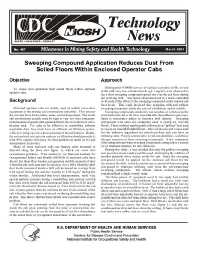Mining Publication: Technology News 487 - Sweeping Compound Application Reduces Dust From Soiled Floors Within Enclosed Operator Cabs
Original creation date: March 2001
Enclosed operator cabs are widely used on mobile excavation equipment in the mining and construction industries. They protect the operator from bad weather, noise, and airborne dusts. The inside cab environment usually must be kept at very low dust concentrations because of quartz dust generated from the excavation of silica-bearing rock. For cabs to be effective in controlling airborne respirable dust, they must have an efficient air filtration system, while providing a positive pressurization of the cab interior. Ideally, the recirculated and exterior makeup air filtration should provide at least 99% capture efficiency for dust particles as small as 0.3microm aerodynamic diameters. Many of these enclosed cabs use heating units mounted or directed along the floor, which can cause dust entrainment problems. Prior studies by the National Institute for Occupational Safety and Health (NIOSH) of enclosed cabs have shown that these floor heaters can generate notable amounts of dust within the cab enclosure. Multiple-shift dust levels measured inside a drill cab increased on average 0.04mg/m3 during the summer months to 0.68mg/m3 during the winter months. Additional dust level measurements, made with optical particle counters during a nondrilling time period, verified that dust levels inside the cab increased from 0.03 to 0.26mg/m3 when the floor heater/fan was turned on. Dust levels within the cab also became greater than the ambient air dust levels outside of the cab when the floor heater was turned on during the nondrilling time period. This shows that the floor heater was a notable dust source problem. Cab floors are commonly soiled from operators tracking dirt inside the cab upon entering from the mine or construction site. Interior cab dust levels can be increased by (1) airflow disturbance of the soiled floor or (2) operator disturbance of the soiled floor.
Authors: National Institute for Occupational Safety and Health
Technology News - March 2001
NIOSHTIC2 Number: 20000987
Pittsburgh, PA: U.S. Department of Health and Human Services, Public Health Service, Centers for Disease Control and Prevention, National Institute for Occupational Safety and Health, Technology News 487, 2001 Mar :1-2
See Also
- Best Practices for Controlling Respirable Dust in Coal Mines
- Closing the Door to Dust When Adding Drill Steels: Uni-directional Cab Filtration and Pressurization System Tested
- Current NIOSH Dust Control Research for Noncoal Surface Mines
- Dust Underfoot: Enclosed Cab Floor Heaters Can Significantly Increase Operator's Respirable Dust Exposure
- Effects of MERV 16 Filters and Routine Work Practices on Enclosed Cabs for Reducing Respirable Dust and DPM Exposures in an Underground Limestone Mine
- Maximizing Air Quality Inside Enclosed Cabs with a Unidirectional Filtration and Pressurization System
- Technology News 463 - Machine-Mounted Continuous Respirable Dust Monitor
- Technology News 509 - A New Method to Clean Dust From Soiled Work Clothes
- Technology News 533 - Minimizing Respirable Dust Exposure in Enclosed Cabs by Maintaining Cab Integrity - TN-No. 533
- Webinar: Protecting Workers in Enclosed Cabs from Silica Exposure: Leveraging Research from the Mining Industry
- Content source: National Institute for Occupational Safety and Health, Mining Program


 ShareCompartir
ShareCompartir
